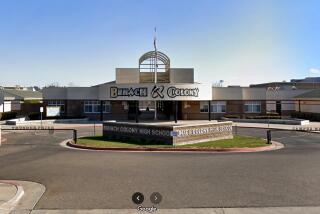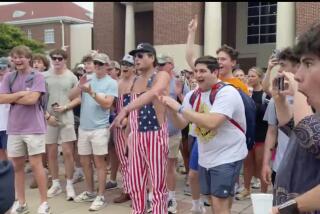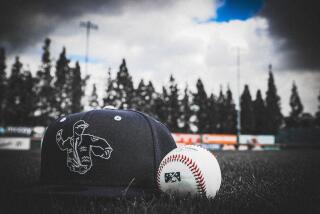Irked by Mascot, Team Retaliates
GREELEY, Colo. â It began as a tongue-in-cheek response to a serious issue.
An intramural basketball team organized by Native American students at the University of Northern Colorado adopted a team nickname, their satiric take on a nearby high schoolâs venerable mascot, the Eaton High Fightinâ Reds.
Thus were the Fightinâ Whites born.
Far removed from the usual fierceness of mascots, the Fightinâ White is depicted as a â50s-style pale male with an earnest face, dimples and gleaming, tidy hair. His smiling visage beams on the front of the team T-shirt. Emblazoned beneath his conservative tie is the slogan, âEvery thangâs going to be all white.â
The team is attempting to accomplish with humor what others have failed to do with countless town meetings across the country: to get the community to discuss in a civil manner the volatile issue of culturally insensitive team mascots.
That hasnât happened. Instead, a rural town and its high school feel unfairly targeted. A tradition is under threat. And a bunch of tightly budgeted college students are sitting on a gold mine in future T-shirt sales.
âWe never expected this to get this big,â said Solomon Little Owl, a forward on the basketball team and the director of Native American Student Services at the university. âWe wanted, humorously, to make a point. âLook at this from my point of view. See how it feels to be made fun of.â If people change their minds, fine. Really, we just needed uniforms and this seemed pretty good.â
The team began wearing the white and red T-shirts a few weeks ago, in solidarity with a local coalition working to rid the stateâs gymnasiums and playing fields of Redskins, Indians and Savages. Since then, Little Owl, from the Crow nation, has received more than 400 e-mails, his voicemail system got so full it crashed and the waiting room outside his office is a logjam of reporters. The team has been inundated with requests to buy its T-shirts.
Up the road in Eaton, about 85 miles northeast of Denver, townspeople are baffled and a little miffed that theyâve been singled out as insensitive clods. Their beloved mascot, they say, has represented the school and town proudly at state basketball tournaments and spelling bees alike. They havenât heard a peep until now.
Certainly there is nothing new about the issue. Despite a resolution passed last year by the National Education Assn. rejecting the use of such mascots and a statement by the Civil Rights Commission calling for an end to Native American images and nicknames in sports, they persist.
The Atlanta Braves have their menacing tomahawk chop. The Washington Redskins, the Cleveland Indians and thousands of college, high school and elementary athletic teams continue to feature mascots that depict snarling, spear-toting Indians.
Many have decried the mascots, but few if any have turned the controversy on its head in this manner. This most recent debate takes place fittingly in the West, where the majority of Native Americans live. Colorado has a Native American population of about 80,000.
Charlie Cuny, a UNC junior, organized the intramural team whose official name is Native Pride. The team is made up of three Native Americans, two Latinos and five Caucasians, the real Fightinâ Whites. The team has a 2-2 record in league play. Cuny, a Lakota, said that for lifelong jocks like him the sports world is drenched in offensive images.
âYou sit down on Saturday afternoon and watch football, and see a Florida State game,â he said. âYou see this Seminole come riding out with his blue eyes and his feathers. He charges across the field and throws a spear down. Iâm thinking, âThat spear is sacred.â To see your culture and religion disrespected like that is not good.â
Dan Ninham, a member of the Oneida tribe, is the doctoral candidate who organized Coloradans Against Ethnic Stereotyping in Colorado Schools. The coalition wants 27 of the stateâs public schools with Indian mascots to consider a change.
Eaton, an agricultural hamlet of 2,500 about seven miles north of Greeley, wishes the coalition would go away. Ninham recently addressed a school board meeting, to a frigid reception. School district Supt. John Nuspl, who has stopped talking to the media, said at the time that the mascot is not derogatory and the groupâs criticism was insulting.
Eatonâs mascot is a familiar Indian caricature: A hook-nosed brave wearing a loincloth, with arms folded over his bare chest and a feather sticking out of a braid.
Assistant Principal Bill Mondt, in an interview this week, made little attempt to disguise his boredom with the topic.
âItâs a joke; itâs all pretty silly,â said Mondt, who is also the head football coach. âThe mascot is not meant to be offensive. Something will always be offensive to someone. That wouldnât be a reason to change it.â
Mondt said there is no connection between the Fightinâ Reds nickname and the Indian brave mascot found on the schoolâs walls and team uniforms.
âThe term âRedsâ weâve had since the school was formed,â Mondt explained. âI think it refers to the Scandinavians who settled this area. They had red hair. The Indian mascot came when Eaton High merged with another school in the â70s.â
Regardless of its lineage, most of Eatonâs 450 students are rallying around the mascot they affectionately call Big Red.
âIf I was Native American, I would be honored to have us named after me,â said sophomore Levi Dyer, awkwardly echoing a common sentiment.
Despite the administrationâs insistence that solidarity exists within the schoolâs staff, a group of Eaton High teachers is circulating a letter calling for the administration to debate the mascot issue.
Tom Trotter, a history and government teacher who has been at Eaton for 17 years, said there are people within the school and town who abhor the Indian mascot but are too cowed to speak out. One teacher who asked not to be named said he uses correction fluid to obliterate the mascot on school stationery before mailing anything.
âThis whole thing could have been avoided if our administration took a leadership role,â Trotter said. âWithout dialogue, people are going to feel defensive. Both sides are going to feel attacked. Itâs human nature.â
Little else has been talked about in town for the last week. Debbie Dusin, a hairdresser at Beauty Haven, said the shopâs usual gossip has been abandoned, supplanted by mascot debates. Dusin, who was herself a Fightinâ Red, said most people donât see any problem with the mascot.
âItâs gone on for years. Why are they just now bringing it up? If they are offended, sorry, but, I mean, why? How is this offending you? They say, âThe big nose, the potbelly,â but those are little things,â Dusin said. âThere are other issues in the world to be worried about.â
To their credit, Eatonians appear to be accepting the Fightinâ Whites mocking mascot with little objection.
Theyâve also become accustomed to the mediaâs glare. Eaton Highâs two story yellow-brick building was besieged this week by reporters. On Wednesday, a Denver radio station showed up and handed out T-shirts with its proposed alternative mascot, a beaver.
Mondt said the students who got the T-shirts would not be allowed to wear them at school.
The shirtâs sexual reference, he said, was offensive.
More to Read
Sign up for Essential California
The most important California stories and recommendations in your inbox every morning.
You may occasionally receive promotional content from the Los Angeles Times.











